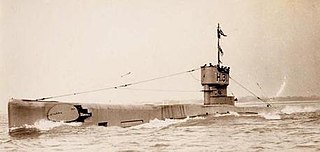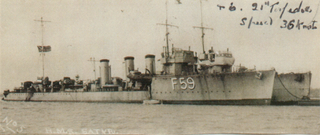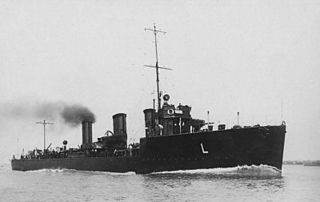HMS R1 was one of 10 R-class submarine built for the Royal Navy during the First World War. The boat was completed shortly before the end of the war and was sold for scrap in 1923.
HMS H44 was an H-class submarine of the Royal Navy. She was built by Armstrong Whitworth and launched on 17 February 1919. She served in the Second World War. She had a complement of twenty-two crew members. She was sold in 1944 and was broken up at Troon in February 1945.
HMS E54 was a British E-class submarine built by William Beardmore, Dalmuir. She was laid down on 1 February 1915 and was commissioned in May 1916. She sank the German submarines UC-10 on 21 August 1916 and U-81 on 1 May 1917. E54 was sold for scrap on 14 December 1921.
HMS H52 was a British H class submarine built by HM Dockyard, Pembroke Dock. She was laid down on an unknown date, launched on 31 March 1919 and commissioned on 16 December 1919, the last Welsh-built fighting ship to enter the British Royal Navy.
HMS H51 was a British H class submarine built by HM Dockyard, Pembroke Dock. She was laid down on an unknown date, launched on 15 November 1918 and commissioned into the British Royal Navy on 1 September 1919. It had a complement of twenty-two crew members.
HMS H50 was a British H class submarine built by William Beardmore and Company, Dalmuir. She was laid down on 23 January 1918 and was commissioned on 3 February 1920. She had a complement of 22 crew members. HMS H50 was one of seven ships to survive to the end of World War II. She was sold for scrapping in July 1945 in Troon.
HMS H48 was a British H class submarine built by William Beardmore and Company, Dalmuir. She was laid down on 30 November 1917 and was commissioned on 23 June 1919. It had a complement of twenty-two crew members. HMS H48 was sold on 30 August 1935 in Llanelly.

HMS H47 was a British H class submarine built by William Beardmore and Company, Dalmuir. She was laid down on 20 November 1917 and was commissioned on 25 February 1919. It had a complement of twenty-two crew members. HMS H47 was sunk in a collision with British L class submarine L12 off Milford Haven, Wales on 9 July 1929. Twenty one of the crew were lost with only three survivors.
HMS H42 was a British H class submarine that sank with the loss of all 24 of its crew after an accidental collision in 1922. The sub was built by Armstrong Whitworth, Newcastle Upon Tyne. She was laid down in September 1917 and was commissioned on 1 May 1919.
HMS H34 was a British H class submarine built by Cammell Laird, Birkenhead. The vessel was laid down on 20 November 1917 and was commissioned on 10 September 1919. She had a complement of twenty-two crew members.

HMS H32 was a H-class submarine constructed for the Royal Navy. The submarine entered service in 1919 and served in the Second World War, one of only seven of the class to do so. During Warship Week 1942 H32 was adopted by Lydney RDC (Gloucestershire). The submarine was sold for scrap in 1944.
HMS H33 was a British H class submarine built by Cammell Laird, Birkenhead. She was laid down on 20 November 1917 and commissioned on 17 May 1919.

HMS H31 was a British H class submarine built by Vickers Limited, Barrow-in-Furness. She was laid down on 19 April 1917 and was commissioned on 21 February 1919.
HMS H30 was a British H class submarine built by Vickers Limited, Barrow-in-Furness. She was laid down on 18 March 1917 and was commissioned on 19 October 1918. It had a complement of twenty-two crew members.
HMS H29 was a British H class submarine built by Vickers Limited, Barrow-in-Furness. She was laid down on 19 March 1917 and was commissioned on 14 September 1918.
HMS H25 was a British H class submarine built by Vickers Limited, Barrow-in-Furness, as part of the Batch 3 H class submarines. She was launched on 27 April 1918 and was commissioned on 16 July 1918. It had a complement of twenty-two crew members.

HMS H28 was a British H-class submarine built by Vickers Limited, Barrow-in-Furness, as part of the Batch 3 H-class submarines. She was laid down on 18 March 1917 and was commissioned on 29 June 1918. H28 was the only British submarine to see active service in both World Wars, and was finally scrapped in 1944.
HMS E47 was an E-class submarine launched by Fairfield, Govan for the Royal Navy and completed by William Beardmore, Dalmuir. She was launched on 29 May 1916 and was commissioned in October 1916.

HMS Sharpshooter was an R-class destroyer which served with the Royal Navy during World War I. Launched on 27 February 1917, the ship joined the Harwich Force, undertaking convoy escort duties. The vessel also took part in the Navy’s bombardment of Ostend later that year. On 1 June 1918, the destroyer rescued Captain A. C. Sharwood, one of the first pilots of the Royal Australian Navy, who ditched his Sopwith 2F.1 Camel nearby. After the war, Sharpshooter joined the Navy gunnery training establishment at Plymouth, but did not stay long and was reduced to Reduced Complement on 5 March 1919. The Royal Navy was rationalising its destroyer force and Sharpshooter, deemed superfluous, was sold to be broken up on 29 April 1927.

HMS Llewellyn was a Laforey-class destroyer that served with the Royal Navy. Laid down on 14 December 1912 as HMS Picton, the ship was renamed on 30 September 1913 under an Admiralty order to become one of the first alphabetical class destroyers, being launched on 30 October. On commissioning, the vessel joined the Third Destroyer Flotilla and operated as part of the Harwich Force during the First World War. The destroyer took part in the Battle of Heligoland Bight, as well as undertaking anti-submarine patrols and escort duties. It was during one of these patrols on 4 December 1916 that the vessel unsuccessfully attacked the German submarine UB-18. On 17 March 1917, the destroyer was struck in the bow by a torpedo launched by a German torpedo boat while rescuing survivors from the sunk destroyer Paragon, but returned to port safely by steaming backwards. With the cessation of hostilities, the ship was placed in reserve. Although subsequently offered for sale to the Finnish Navy, Llewellyn was instead withdrawn from service and sold to be broken up on 18 March 1922.





